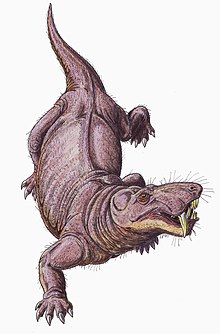Gorgonopsia, meaning 'gorgon face', were mammal-like, with heterodont teeth, ear bones and temporal fenetraes (skulls characterised by bilateral, symmetrical holes, or fenestraes, in the temporal bone.), though it's unknown whether they had scales, fur, or just naked skin. They're one of three groups of theradonts, and are a close relation to mammals, through cynadonts, another group of theradont.
There are 19 families of Gorgonopsia, and three subfamilies. The three subfamilies of Gorgonopsia are Gorgonopsinae, Inostranceviinae and Rubidgeinae, and contain three, two and four species respectively.
Gorgonops is the most common genus of Gorgonopsinae, that grew to 2-2.5 meters long, and had 12-cm sabre teeth, similar to smilodon. Gorgonops were faster than the majority of Gorgonopsinae because of their long legs under their body. There are three definitely known species of Gorgonops:
- Torvus, the type species. A medium-sized Gorgonops characterised by a longer snout and some difference in skull structure.
- Whaitsi, a larger Gorgonops, with a wider skull rear and details of proportion.
- Longifrons, a large Gorgonopsid with an larger skull-orbit and snout than Whaitsi.
There are three other species, though they're either uncertainly placed, or synonyms. These are dixeyi, kaiseri, and eupachygnathus.
Artist interpretation of Whaitsi
Torvus, by Theropsida
Longifrons, also by Theropsida
Gorgonops have been in popular culture a couple of times. In 2005, a Gorgonopsid was featured in Walking With Monsters, but was specified as a Gorgonops in the companion book, though as it was shown preying on a scutosaurus, it was likely a different genus of Gorgonopsid, as Gorgonops and scutosaurus lived in separate countries. It was also shown in the 2007-present ITV-sci-fi, Primeval twice.
Another Gorgonopsinae is Sauroctonus, a 3 meter long gorgonopsid with a triangular skull, and a primitive parietal eye. They had a pair of huge canines on the upper and lower jaws, larger on the upper jaw. Their other teeth were smaller and pointed, and tiny blunt teeth were found on the palatine bone. The lower jaw was widened to form a chin, and their long, lightly-built limbs resembled mammalian limbs. Despite having mammalian characteristics, they're not ancestors of mammals. There are two species of Sauroctonus, Parringtoni and progressus.
Artist impression of Sauroctonus
Another genus of Gorgonopsia is Scylacops, a moderately-sized relative of Progressus Sauroctonus, composed of two species, bigendens and capensis.
Scylacops bigendens, by theropsida
In the subfamily Inostranceviinae, the first genus is Inostrancevia. Inostrancevia had an upright posture of 1-4.3 meters long and strong muscular attachments. They had larger temporal fenestras and smaller eye sockets than less advanced therapsids. The upper jaw contained 10 small back teeth, 6 large incisors, and 2 larger canines. Their lower jaw was composed of 6 large incisors, and 8 small incisors.
An artist impression of an Inostrancevia and a scutosaurus
There are four species of Inostrancevia, Amalitsky, l. Pravoslavlev,Tatarinov, and v. Pravolsavlev.
Pravoslavlevia is another genus of Inostranceviinae. Only one species of Pravoslavlevia is known, Parva. Their total length was around 1.4 meters, making them a particularly small Gorgonopsid.
Artist impression of Pravoslavlevia Parva
The last subfamily of Gorgonopsidae is Rubidgeinae, and the first genus is Broomicephalus. They were small gorgonopsids with long, broad snouts, only about 1.1 meters in total.
Artist impression of Broomicephalus.
Niuksenitia is another genus of Rubidgeinae, but I can't find any information on it.
Prorubidgea is also a genus of Rebidgeinae, containing 6 species, Alticeps, Brinki, Brodiei, Maccabei, Pugnax and Robusta, but I couldn't find any more information on it.
The last genus is Rubidgea, a 2.4 meter gorgonopsid with very large canines, which contains one known species, Atrox.
Artist impression of Rubidgea Atrox.
There are another 19 families of Gorgonopsids, but I'm very tired, and have an exam in the morning. I may return to them, but for now, I do need to sleep.
From my blog, The Last Lemurisian










1 comment:
Not bad. A page about Gorgonopsians can't be :)
Post a Comment